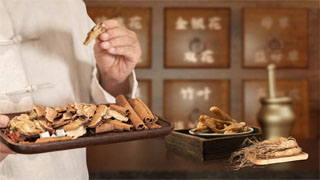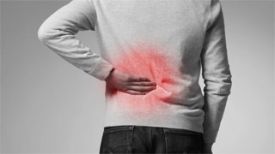
Those who have experienced it know that sciatica is not an ordinary pain.
The sciatic nerve mainly originates from the waist, passes through the buttocks, posterior thigh, lateral calf to the feet, and controls sensory and motor functions along the way.
Once the pain starts, it not only affects the entire person's activity, but also creates a burning sensation like an electric shock that is unbearable.
Sciatica is classified as a "bi syndrome" in traditional Chinese medicine. Simply put, it refers to the invasion of external pathogens into the human body, which leads to poor blood circulation, blockage of meridians, lack of blood circulation, and pain.
The external evil mentioned here refers to the wind evil, cold evil, and dampness evil that people often refer to.
Wind pathogenic factors can exacerbate the occurrence of migratory pain in the body, while cold pathogenic factors can exacerbate the degree of pain, usually worsening when exposed to cold or at night.
Dampness and evil often manifest as a specific part of the body, mainly characterized by heaviness and fatigue on the outside.
What has a greater impact on sciatica is the cold pathogen.
An ancient medical classic introduces a small prescription of four medicinal herbs that can effectively alleviate symptoms of sciatica.
This recipe is called Zaojiao Ci Tang, which is composed of Zaojiao Ci, Weilingxian, Chicken Blood Vine, and Licorice. Boil these four medicines in water and drink them, take one dose a day after meals.
Reference Dosage: 30g of soapberry thorn, 10g of Chinese wolfberry, 10g of chicken blood vine, 10g of licorice
Zaojiao Ci Xin San Wen Tong, extremely sharp in nature, perfectly deals with the cold pathogen of sciatica. It has thorns, so it has stronger penetration and can reach deep into the lesion.
In clinical practice, it is mainly used to treat sores and lumps. If pus has not yet formed, soapberry thorns can promote the generation of pus. If it has already ruptured, soapberry thorns can promote the dissipation of pus and shorten the course of the disease.
Through long-term clinical practice, it has been verified that soapberry thorn has the effects of promoting meridian circulation, activating collaterals, removing blood stasis, dispelling wind, dispersing cold, and relieving pain, and the analgesic effect is rapid.
Literature research shows that the dosage of soapberry thorn should be large, with adults generally consuming 20-50 g per day. If it is less than 20 g, the therapeutic effect will be significantly reduced.
When used in high doses, only a few patients experienced mild nausea or diarrhea, and no obvious adverse reactions were observed. After multiple doses, the adverse reactions disappeared.
In fact, this single ingredient of soapberry thorn can already effectively deal with sciatica, but adding three other medicinal herbs will help soapberry thorn to perform better.
Chicken blood vine is mainly used to promote blood circulation and remove blood stasis. The final pathological product of sciatica is blood stasis, because when exposed to cold, there will be blood stasis. When our blood vessels are warm, they move; when exposed to cold, they coagulate.
It's like a cold winter when rivers freeze, but in spring when flowers bloom, the ice and snow melt away.
The main function of Weilingxian is to dispel wind and dampness, which has a great effect on the treatment of rheumatic and rheumatic diseases.
It can also play a role in promoting meridian circulation, activating collaterals, reducing inflammation and pain, and can be used to treat various diseases caused by rheumatism and rheumatism, especially to improve symptoms such as systemic migratory rheumatism.
If reactive arthritis, rheumatoid arthritis, and a type of osteoarthritis are found, a formula composed of Weilingxian can be taken to regulate them, which can alleviate symptoms such as sciatica and lumbar pain.
The last flavor of licorice is to protect the spleen and stomach, as the medicinal herbs used to treat rheumatism tend to be warm and dry, which can easily damage the spleen and stomach;
Secondly, licorice can supplement body fluids and prevent excessive internal heat. The first three medicines are too dry and can be a bit harmful to yin;
Thirdly, licorice itself has a pain relieving effect, which can alleviate pain in a slow and urgent manner. Any urgent pain can be relieved with licorice.
Finally, we would like to remind everyone that any disease should be treated based on age, disease duration, symptoms, and other factors. It is not advisable to blindly follow the traditional Chinese medicine formula, and the adjustment of the formula should also be based on the improvement of the condition.
Attachment: Case of One Flavor Zaojiao Ci Tang
Secret recipe: 120g soapberry thorn.
Usage: Boil in water and drink frequently as tea. Take one dose per day.
Case: Peng, male, 40 years old.
The patient's right leg is swollen, hard, and painful. During the pain, the waist cannot stand on its own and movement is inconvenient. After multiple examinations, the diagnosis is phlebitis. Seeking medical treatment for ineffective use of traditional Chinese medicine.
After more than 20 days of continuous use of this formula in clinical practice, the leg pain disappeared and the patient recovered.
Solution: This formula has the functions of opening and closing the orifices, attacking toxins and promoting stagnation, breaking blood stasis and reducing swelling, and dispersing toxins through ulceration. Indicating for patients with breast abscess, malignant sores, cervical wind, and muscle abscess.
The clinical application of this formula has treated multiple cases with unique and significant therapeutic effects. Follow up for many years has not shown any recurrence.


